
My daughter attends an International School here in Singapore. It follows an American curriculum. She has been attending the school since first grade (she’s now in middle school, 6th grade), and she feels a warm sense of community and perceives it as a second home.
Quite recently, I attended an orientation about the school’s Accelerated Reader programme which started last year, but is said to be in greater effect this year now that they have ironed out quite a number of technological kinks in the system. I am familiar with the programme as my eleven year old daughter has walked me through the website, and I did have quite a few queries.
First Thoughts
I was initially excited to find out that my daughter’s out-of-school reading would be earning ‘points’ through this system. I remembered being such a voracious reader when I was also her age – I devoured the entire Sweet Valley High series, Sweet Dreams series, and a few classics too (Louisa May Alcott’s Little Women, Mark Twain’s novels), whenever I get my hands on them from relatives. My daughter and I started typing down a few titles that she has read over the summer just to check whether AR has them:
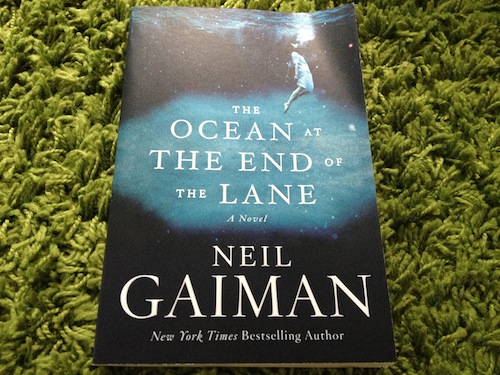
The Ocean at the End of the Lane by Neil Gaiman is a novel that we read for our book club of 9-12 year olds (GatheringReaders) at the Jurong West Public Library in August this year. Not on the list. I begin to realize that perhaps the recently published books (2013) may not be in the catalog as yet.
And so, I tried a well-known classic, one that has been published in the year 1918 in Australia and has been reprinted by the NYRB Children’s Collection: The Magic Pudding by Norman Lindsay.
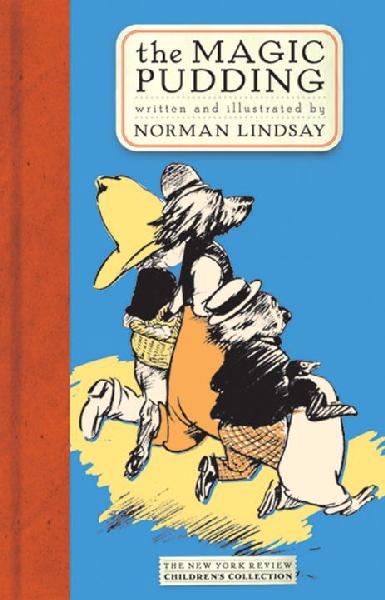
Again, not on the list. A few warning bells start ringing in my ears. This is also one of the books we have discussed in our book club at the library for the month of September. Hmm.. Does this mean that only American titles can be found on the AR list? Yet, this celebrated Australian children’s book classic has been reprinted by the NYRB in 2004. Still, doesn’t matter. The title could not be found on the list. And so my daughter automatically “loses points” for these books. The minute I started thinking that way, the more I begin to feel, something’s not right here.
Orientation Proper
When I attended the orientation a few weeks back, I was in the thick of reading Penny Kittle’s Book Love, and I already finished reading Kelly Gallagher’s Readicide: How Schools are Killing Reading and what you can do about it.
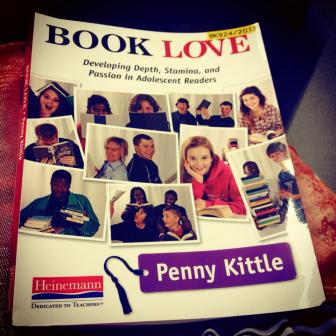
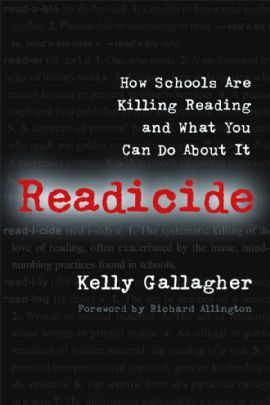
These are only some of the books that I am reading in preparation for a new course that I hope to teach in January next year: The Use of Multicultural Children’s Books to Promote Socio-emotional Learning. This will be opened to higher degree students, teachers who are taking their Masters of Education by Research, those who are pursuing their PhDs, and even teachers who are taking their Masters by Coursework. So I am pretty excited about this. Hence, I was just reeling from the information I have just gained from these two beautiful books when I attended the orientation, which may have prompted me to write this overly-long piece.
I have also shared this piece before I published it today to our Librarian, Middle School and High School Principal. Our MS Principal very kindly told me that the AR only functions as a supplementary program and that it is not meant to replace their Literature class where the students can still be exposed to a variety of titles and that it is meant to encourage reading outside the classroom.
During the orientation, the parents who attended were walked through the website – some are more familiar with it than others. It was also noted that different teachers make use of the AR program in a variety of ways in their own classrooms. I could see that our librarian feels very passionate about the programme and that she is devoted to motivating kids to become readers. She even gives out little rewards and prizes to kids who have met or exceeded their reading goals. My daughter has received quite a few of those and she does get extremely excited by it.
Then the discussion about the AR reading levels ensued. This is where most of my issues lie.
A few concerns about AR
Concern #1: How to deal with already-motivated students, the avid readers?
My field of specialization is in gifted and talented education. While the children from this group belong to the other extreme of the “bell curve,” and are relatively fewer compared to the larger number of children, I believe that they should be fed as many quality books as they wish. And so where I am coming from, I see nothing wrong with precocious first graders checking out fourth-grade level books (something which is not recommended by the AR programme) if the titles speak to them and they have the requisite scaffolding to guide them through the text either through a helpful mentor-teacher or a parent and emotional readiness to understand some of the bigger themes covered in the book which is largely contingent on what the family considers to be valuable or important. I tend to regard children’s recommended reading range as such – just mere recommendations.
I am well aware of Piaget’s stages of cognitive development, one of the foundational theories I teach at the university. I am deeply aware that as a child’s mind develops and matures, they move beyond concrete ideations to abstractions, and that there are stages to this. Yet, these stages are never etched in stone – some may soar and fly, while others may be slower to warm up, others may not even fall neatly in the pre-established categories.
How does AR deal with students who are already motivated to read? How would the incentives for them be differentiated? Do they get penalized for reading books that are not included in the list? While they don’t get clear ‘penalties,’ they are not given points as well, which is essentially withholding reinforcement, something that may be perceived as a penalty by others. Would the same token system of reinforcement work for them in the first place? And what about first graders who do read third or fourth grade novels? Or fifth graders who read Alexandre Dumas’ The Count of Monte Cristo (I know of one in particular who is part of my book club)? They can’t take the test because they shouldn’t be reading those novels in the first place?
And so I tentatively raised a question during the orientation. While my heart was full and my head was brimming with so many ideas I longed to write down, I also did not want to appear negative or unsupportive of the programme, because on the one hand, I could also clearly see its value. Perhaps, it is made for a different purpose, and so I asked the question: what is the objective behind the programme? Apparently it is meant to motivate students to read more, for them to enjoy reading. For other children, they need a ‘carrot’ dangled in front of their noses to get them to read, which I agree is true enough for most.
However, this made me ask even more questions in my mind, and I invite fellow teachers, librarians, other friends to share their thoughts about this, because I truly want to know. This is not meant to disparage or belittle a programme which I am sure has received a great deal of research and support. I even debated with myself whether I should blog about my thoughts, but I know that I feel very passionately about reading and books and teaching to not raise a few issues that concern me, and that they are being shared here in the spirit of a more dynamic conversation about our children’s appreciation of literary texts.
Concern #2: On Recommended Reading Range/ Leveled-Readers
In the book that I co-edited and published quite recently (Beyond Folktales, Legends and Myths: A Rediscovery of Children’s Literature in Asia),
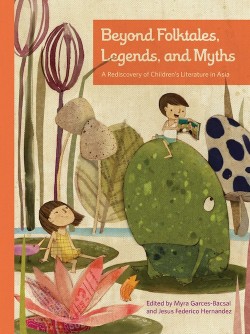
the first chapter of the book is my conversation/interview with children’s literature expert and historian, Leonard Marcus from New York. One of the questions I asked him had to do with this:
(Myra Garces-Bacsal): What are your thoughts about the labels that indicate the age– appropriate level at the back of most children’s books? We discussed earlier that board books are important because developmentally that is how children would engage with the actual book itself. Do you ascribe to the recommended age-range often found at the back of the books? What are the pros and cons of using such age-specific labels for books?
(Leonard Marcus): Well the principal con is that a label of that kind contradicts the fact that a book can be used in different ways by children of different ages. And a parent who does not know that already might be led to believe otherwise. The labels can promote overly-rigid thinking about the uses of children’s books. That is the primary con. Take Goodnight Moon as an example.

It is a book that you can read to a newborn for the sake of the rhythm. Read it with a two year old who is just learning his or her first words and it becomes a great chance for the child to practice pointing–and–naming different words and things. At five years old, a child who is learning to read independently can feel the satisfaction of reading a book with a short text from beginning to end. At seven, a child can read the book to a younger brother or sister. So, there are several different ways of using Goodnight Moon.
I have taught at various colleges over the last many years, and I once had an art student come up to me after class with a question she was too embarrassed to ask in front of her peers. She said she had a 12 year old sister who still looked at picture books. Did I think there was something wrong with her? I said, “Well, no. It could be that she is interested in becoming an artist. Maybe, maybe not. But either way, if it interests her, why not? What could possibly be bad about that?” Of course there is an answer that people have given, which is that reading books that are below one’s supposed age-level may indicate some kind of intellectual laziness or failure in development. In fact, a lot of people would say that. Sadly, here and maybe in other countries too, there are many ambitious parents who want their children to go to good colleges, and begin thinking from the start how to accelerate their children’s education in order to give them the best chance at breaking through the competition for acceptance by Harvard or Yale. One of the principal ways in which a parent tries to do that is by pushing their child to read books that are more and more advanced, at an earlier and earlier age. To me, that is sad because the most likely consequence of forcing a child to read a book that he or she is not ready for is that it will eventually turn that child off to reading altogether.
Now, the pro of reading age–level indicators on books is simply that they give otherwise uninformed adults, parents or others, some guidelines to start from. But it needs to be understood that these are not hard–and– fast rules. (pp. 24-25)
Concern #3: Titles that are not included on the AR list
How about books written in a foreign language? Does this mean that if you read a book written in your first language (e.g. Spanish, Chinese, Filipino) or are written in English but are not published in the US or the UK, that it does not count as ‘legitimate’ reading as well, as defined by the AR programme? I searched for Jose Rizal’s Noli Me Tangere and El Filibusterismo, classic novels and required reading in Philippine literature, and was not surprised to not find them on the list.
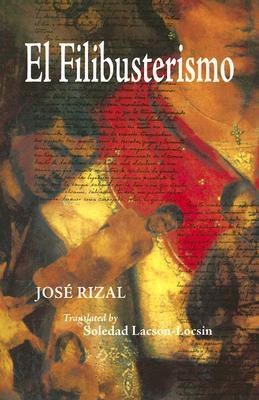

My fear is that parents might even start restricting their children’s reading materials and to “read smart” so that they earn points for their recreational reading, which would be a serious tragedy as there are wonderful titles out there that are not even included in the AR list, as you’d see more below.
Concern #4: Bias Against Graphic Novels and Novels-in-Verse?
My eleven year old daughter is crazy over graphic novels. Much to my chagrin, I see that she could not even take the test for some of the graphic novels we have discussed in our book club sessions at the public library – because they fall way far below her recommended reading range. Take for instance, the multi-award-winning graphic novel American Born Chinese by Gene Luen Yang – is only deemed to be in the 3rd grade level.
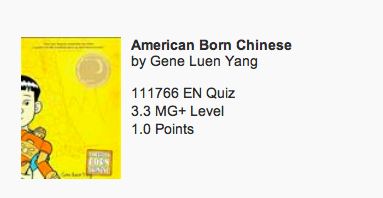 American Born Chinese: Finalist for the 2006 National Book Awards in the category of Young People’s Literature, won the 2007 Michael L. Printz Award, the 2007 Eisner Award for Best Graphic Album, the San Francisco Chronicle Best Book of the Year, the 2006/2007 Best Book Award from The Chinese American Librarians Association
American Born Chinese: Finalist for the 2006 National Book Awards in the category of Young People’s Literature, won the 2007 Michael L. Printz Award, the 2007 Eisner Award for Best Graphic Album, the San Francisco Chronicle Best Book of the Year, the 2006/2007 Best Book Award from The Chinese American Librarians Association
Even if my sixth grader takes a multiple-choice quiz that is supposed to magically demonstrate her full understanding and ‘comprehension’ of the material, she would only earn 1 point for it.

I remembered discussing this novel with my book club kids (aged 9-12) – we talked about issues such as finding home in a foreign land (something that most of them are struggling with, being children of expatriates in Singapore; even local kids shared issues about contending with the changing landscape of their community).
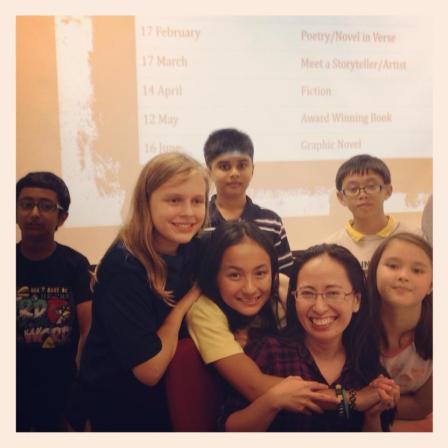
We also talked about self-loathing, how language shapes thought, and how one finds self-acceptance. Our book club discussion marked one of the most beautiful conversations I’ve had with young children: so heartfelt, authentic, and true. But a multiple-choice type of assessment would only give this book a measly 1 point. Then I typed a few more graphic novels that I enjoyed, and here were the results:
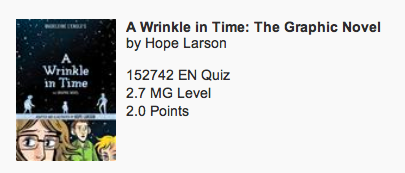
A Wrinkle in Time: CCBC Choice (Univ. of WI), Eisner Award Nominee, Eisner Award Winner, California Library Association – Best Graphic Novels, Maryland Black-Eyed Susan Award Maser List
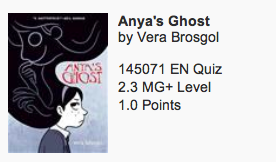
Anya’s Ghost: American Library Association Notable Children’s Books, American Library Association Popular Paperbacks for Young Readers, American Library Association Quick Picks for Reluctant Young Adults, YALSA Great Graphic Novel for Teens, BCCB Best Book of the Year, CYBIL Award, Eisner Award Winner, Graphic Novel Reporter Best GN of the Year, Jezebel.com Best Female Creator of the Year, Amazon.com Best of the Year So Far, Booklist Editors’ Choice, Booklist Top Ten First Novels for Youth, Bulletin of the Center for Children’s Books Blue Ribbon Award, Horn Book Magazine Fanfare List, Kirkus Reviews Best Books of the Year, Library Media Connection Best of the Best, School Library Journal Best Books of the Year, Bram Stoker Awards – Nominee, Indiana Young Hoosier Award Master List, New Jersey Garden State Teen Book Award Master List, North Carolina Children’s Book Award Master List, Virginia Readers’ Choice
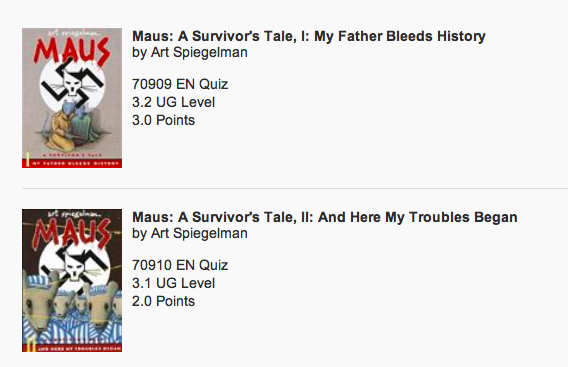
2 points for Maus II, 3 points for Maus I. Evidently, graphic novels are perceived to be lacking in literary merit to even deserve precious points, never mind that they won the Pulitzer Prize for Literature like Maus.
And it appears like novels-in-verse suffer the same fate as could be seen below – see the points allocated to these award-winning-books:

Inside Out & Back Again: Winner of the 2011 National Book Award for Young People’s Literature, 2012 Newbery Honor Book

The Surrender Tree is a 2009 Newbery Honor Book, the winner of the 2009 Pura Belpre Medal for Narrative and the 2009 Bank Street – Claudia Lewis Award, and a 2009 Bank Street – Best Children’s Book of the Year.
On a lark, I typed The Diary of a Wimpy Kid by Jeff Kinney – a novel which, by the way, my daughter is crazy about:
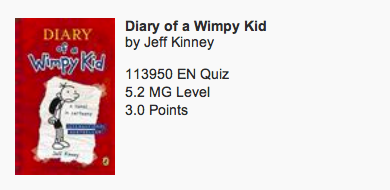
I find it a trifle odd that taking the test for the Diary of a Wimpy Kid, perceived to be at the fifth grade level (middle grade) would earn a child even more points than a Pulitzer-Prize winning graphic novel (with Maus II being given only two points, this being classified under upper grade level). Granted that my daughter and I read Maus when she was in the fourth grade – but clearly its themes and the conversations that Spiegelman’s stories engender are of a different world altogether – in fact, the two stories are not even comparable, to be fair. Yet, AR does make such a comparison, however subtly, despite one novel being in the UG and the other in the MG level, by reducing both to seemingly-arbitrary points that tackle widely different themes for the sake of convenience.
I also typed in Raymond Briggs’ graphic novel Ethel and Ernest which won the “Best Illustrated Book Of The Year” at the 1999 British Book Award and tells the story of Briggs’ parents’ lives and is a truly remarkable piece of work:
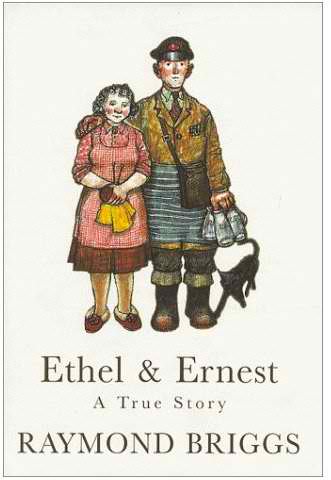
No surprises, it’s not on the list. Which brings me to my next point:
Concern #5: On Visual Literacy and the Value of Picture Books
Does the AR not consider visual literacy as an important component in a child’s journey to literature? There seems to be an expectation that as kids become older, they must outgrow picture books. An indicator that they are progressing in literacy is evidenced by the thick pages they read with neither pictures nor dialogue. The more information packed in the thick book, the better it is perceived to be. I am reminded of the first few lines found in Lewis Carroll’s Alice in Wonderland:
Alice was beginning to get very tired of sitting by her sister on the bank, and of having nothing to do: once or twice she had peeped into the book her sister was reading, but it had no pictures or conversations in it, “and what is the use of a book,” thought Alice, “without pictures or conversation?”
There is such a thing as visual literacy, the appreciation of intertextuality, the synergistic interaction between images and narrative, the multiple layerings of artwork and text. These are important elements that are totally lost in the entire world wrapped around the point-system-ranges of AR. My heart constricts and I find myself hyperventilating each time someone claims with absolute certainty that picture books are only for babies, or picture books are not for advanced readers, and that the market for picture books should only be for kids nine years old and below.
How about the picture book British classic which has an almost cult-like following Raymond Briggs’ Fungus the Bogeyman, a book that talks about the existential crisis faced by a bogeyman who contemplates about a life different from the one that is set out for him by virtue of his birth?
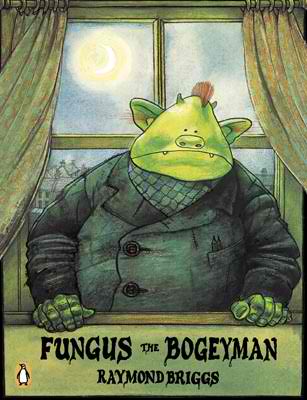
No surprises: not on the AR list.
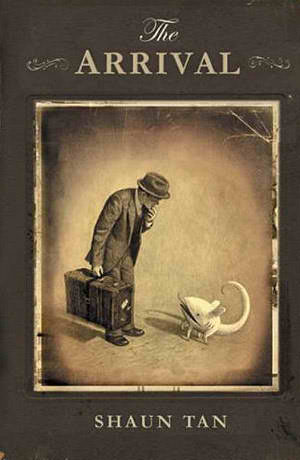
I searched for Shaun Tan’s The Arrival, a cinematic visual and wordless masterpiece which incidentally made it to the top 100 Great Children’s Books as selected by children’s librarians at The New York Public Library and won all of these other major awards:
New South Wales Premier’s Literary Award
2006 Cybils Award
Bologna Ragazzi Award, Special Mention
Spectrum Award
Junior Library Guild Selection
World Fantasy Artist of the Year
A Publishers Weekly Best Book of 2007
A New York Times Best Illustrated Book of 2007
Amazon.com’s Best Teen Book of 2007
2007 Parents’ Choice Gold Award
A Book Sense Winter 2007-2008 Top Ten Children’s Pick
A New York Public Library Best Book for Reading and Sharing
A New York Times Notable Children’s Book of 2007
Rocky Mountain News, A Top Ten Book of the Year
The Columbus Dispatch, A Best Book of 2007
Booklist Editors’ Choice 2007
A School Library Journal Best Book of 2007
A Washington Post Best Book for Young People for 2007
Bulletin of the Center for Children’s Books Blue Ribbon for Fiction
ALA Notable Children’s Book, 2008
ALA Top Ten Best Books for Young Adults, 2008
ALA Top Ten Great Graphic Novels for Teens, 2008
Horn Book Fanfare Book 2007
Metropolitan Home Magazine’s Design 100, 2008
An IRA Notable Book for a Global Society, 2008
2008 Locus Award, Best Art Book
2008 Boston Globe-Horn Book Award, special citation for excellence in graphic storytelling
CCBC Choices 2008
Nominated for an International Horror Guild Award, Illustrated Narrative
Not on the AR list.
I looked for Anthony Browne’s exquisitely detailed picture books layered with multiple meanings and visual metaphors. I found a few and are rated as such:
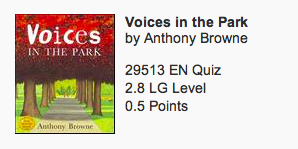
Voices in the Park won the 1998 Kurt Maschler Award and was shortlisted for the Kate Greenaway Medal.
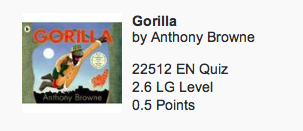
Gorilla won the 1983 Kurt Maschler Award and 1983 Kate Greenaway Medal
I also looked for other picture books that deal with big themes such as The Rabbits by John Marsden and Shaun Tan which is an allegorical tale that confronts highly sensitive issues about colonization from the point of view of the colonized; or Rose Blanche by Roberto Innocenti that talks about the devastation of war.
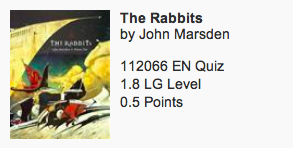 Picture Book of the Year by the Children’s Book Council in Australia
Picture Book of the Year by the Children’s Book Council in Australia
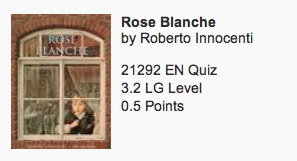
Winner of the Batchelder Award, 1996
The AR list does not include Armin Greder’s disturbing picture books such as the one that I reviewed a year ago:
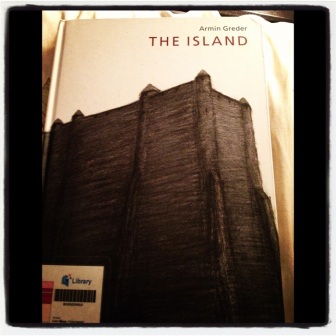
My fear is that parents who may not be familiar with these picture books and poetry books, and who may simply be relying on the point-system allocated in the AR may even go as far as dissuade their children from reading these wonderful titles as they would not earn as many “points” as other books and would not help them in reaching their ‘reading goals’ much faster.
Increasingly, there are more picture books that tackle sensitive issues and themes that are worth discussing at a middle school or even upper grade level and would work as a great companion text to a few of the social issues being discussed in class or even in some of the historical details covered in the curriculum – something which is not captured in the point system used in the AR programme. I teach graduate school and I read picture books aloud in class. Never fails, always works.
Once again, let me quote from the interview that I have with Leonard Marcus:
(Myra Garces-Bacsal): Most people do not seem to realize that there are a lot of picture books for older readers, and it is something that is often not explored.
(Leonard Marcus): That is becoming more and more common, to have picture books that trend upward in sophistication. And it seems fair to say that the picture book is merging with the graphic novel to some extent. We are moving into a period when the stigma that was once attached to the heavily illustrated book is probably going to disappear. In other words, it used to be that people started with books with pictures, then graduated to books without pictures and that was considered an advance. Now, I think people understand that complicated, sophisticated books for older readers can have lots of pictures too—that there is nothing babyish about that. (p. 25)
Concern #6: What does research have to say about AR?
As an academic, I can not help but ask this question. For this, let me quote from a passage that I’ve read in Kelly Gallagher’s Readicide:
… it has become increasingly popular in school districts across the country to stick struggling or reluctant readers into packaged programs that reward students with points for reading books. Accelerated Reader (AR) is one such program. In AR, students are given mindless multiple-choice quizzes after they finish each book, and if they pass these quizzes, they are awarded points. Earn enough points and they progress to higher-level books in the program. In AR, the good news is that students read a lot of books. The bad news?
- Students can only read books found on the AR list. If a good book is not on the list, students are not allowed to read it.
- Students choose books for high point value, rather than for their level of interest.
- The reward system sends the message that the reason students should read is not to enjoy reading but to earn points. Students are taught to read for the wrong reasons.
- Chenowith (2001) found that although students did a significant amount of reading in the program, their reading dropped lower than nonparticipants within one month of exiting AR. Without the points, their motivation significantly decreased.
- Pavonetti, Brimmer, and Cipielewski (2002/2003) found that once students left AR they read on average ten hours a week less than nonparticipants. The program had short-term success but actually set young readers back in the long run.
Many teachers like Accelerated Reader and similar incentive-laden programs because they see students do a significant amount of reading. What they don’t see is that programs such as AR and others that offer extrinsic rewards often lead to demotivating students after they have left the classroom. (Gallagher, 2009, pp. 74-75)
I also welcome other academics, teachers, librarians, programme coordinators to share with me other research studies that might show otherwise, or demonstrate different research results, or even just a different experience in their schools altogether.
Recommendations/ Suggestions
I understand that it may not be the objective of the AR programme to develop “lifelong readers” but merely to encourage and entice children to read, particularly the reluctant readers. I am not disputing that. We need to ask ourselves, though, why do we encourage them to read? What is it about reading that makes it so important? And if we are indeed successful in encouraging even the most reluctant reader to pick up a book and read, what next? Where to go from there?
I see that the Accelerated Reader programme is well-intentioned, and that it provides the much-needed incentive for a lot of children to read. However, it is only one facet in a child’s reading life, and it is disastrous to perceive it as the entire picture. If our intention as educators, as parents, as book enthusiasts – is to develop lifelong readers, then we need to move past multiple-choice assessment tools, honor the children’s choices of reading materials (irrespective of recommended reading levels), and encourage the reading of more multicultural titles that are not only exclusive to those published in the US or the UK. As such, I have a few recommendations on how the programme may be enriched.
Recommendation #1: Reading Notebooks and a Reading List
Children could be encouraged to keep their own reading notebooks where they could make a list of titles that they have read. Here, they can jot down and include some of the titles that are not found on the AR reading list. Their teachers may or may not choose to reward them for this, but it would make for good conversations with other students who may want to consider the titles in their own reading list, despite their not earning points for them, especially if they are outstanding reading materials. It also serves to demonstrate the variety and the diversity of a child’s reading life that goes beyond the Accelerated Reader Programme. Their list may even include National Geographic titles (which by the way are not found in AR), Horrible Histories or Horrible Science titles by Terry Deary (also not included on the AR list), interesting newspaper articles that they may have read over the past weeks, Charlie Brown’s encyclopedia (again, not on the AR list), graphic novels, or even picture books that caught their eye. We are also doing this here in GatheringBooks with our Annual Reading Calendar. Erik Weibel from This Kid Reviews Books has his own reading list that you can see here.
Recommendation #2: Reading Journals
In Penny Kittle’s Book Love, she made mention of notebooks where students can write down their unstructured thoughts about the novels that they are reading. If we truly want to develop lifelong readers and want to see how much they have understood their reading materials, then their capacity to engage with the characters of the book is one of the best ways to go about it. Recall that these are not full-length graded essays or even book summaries; this is the student’s private space to reflect on specific lines that moved them, to wonder about a character’s growth in the novel, their frustration with the narrative or the plot.
As a teacher, I would like to see my students argue with the characters in the book, I’d love for them to discern their motivations, their strengths, commiserate with them over their losses – I want them to tear the pages apart and see the pieces there that resonate with them, the aspects of the book that reflect their own truths, their own inner journeying and deep-seated questions about who they are and their place in the world. I want them to follow a specific author and see how much the author may have grown in his or her writing style over the years and discuss the finer points of one book over the other and perhaps cull out similar themes from the novels.
I want them to extract pages from the book and turn these over in their hands, rolling the words over with their tongue, poking the pages in multiple ways, and having them wear the words to see if they make a good fit. I want them to bring who they are to the pages and listen to the book’s voice, despite its being an unfamiliar tongue – coming perhaps from a different world, or a different dimension altogether, yet honoring its truth nonetheless.
Recommendation #3: Book talks with Kids
This is predicated upon knowing each child and seeing which book would work best for them. It is more than just looking at the AR program and typing down their recommended reading range and seeing the titles that they should check out to make the most number of points. There are kids who are into trucks, what books might engage them? There are kids who are deeply into fairies, enchantment, and magic – perhaps the Warriors series, the classic Wizard of Oz, or Neverending Story by Michael Ende might work for them. Are they into poetry, then share with them a few novels-in-verse.
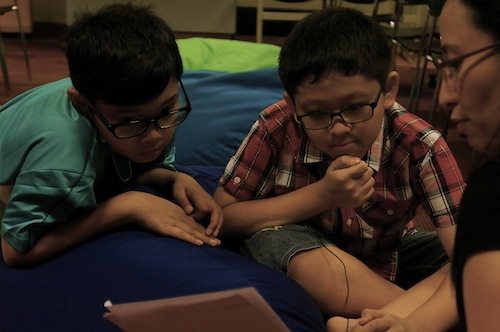
Are they into war and fighting and revolution, then it would be good to share the website of the NCTE Orbis Pictus Award for Outstanding Nonfiction for Children with them. Are they suffering from a recent loss, then perhaps Patrick Ness’ A Monster Calls might speak to them. Are they into horror novels and are already reading Goosebumps or Darren Shan? Perhaps Mary Downing Hahn may challenge them to think a little more differently, then gradually moving towards, say, Ray Bradbury’s Something Wicked This Way Comes.

Recommendation #4: Book talks with Parents
I believe that it is important for parents to have a more informed knowledge about the different facets of the Accelerated Reader programme and to regard this as only one aspect of their children’s reading life. During the orientation, I could see that there are a lot of parents who are hungry for titles that they could share with their own children. Organizing book talks with them would be wonderful. They could also be linked to so many fabulous websites that exist out there that look into multicultural children’s book titles.
Aside from Newbery Medal and Honor titles, there are so many other award-giving bodies out there that parents may want to familiarize themselves and their kids from various parts of the globe. In fact, we made a list of this as we are currently hosting the Award-Winning-Books Reading Challenge here in GatheringBooks for two years now. This is not meant to be an exhaustive list, but it would make for a good start. Here is an extract from my blog post:
If you want to have a complete list of children’s and YA book awards from different parts of the globe, click here to be taken to a comprehensive list prepared by the UCalgary. Library Quine from Loons and Quines has also provided us an updated version from the web site of the Book Trust (UK) which provides links to newer UK awards. For the Carnegie and Kate Greenway Awards, you may want to check out this website for a more updated archive. The Scottish Book Trust lists Scottish awards here. Many thanks to Library Quine for all these links.
Other examples would include the Newbery and Caldecott Honor/Medal from the United States, the Pura Belpre, Coretta Scott King Award, Jane Addams Children’s Book Award, Michael J. Printz Award, The Stonewall Award, Cybils Awards among others.
Recommendation #5: Reading Levels as only one pathway to book selection for children.
Just a few days ago, one of our book blogging friends, Amy Broadmoore has just shared her own thoughts about this issue entitled Leveled Early Readers: Valuable Tool or Marketing Ploy. In her post which I read quite avidly she shared how some of the ‘early readers’ books may contain difficult words that may discourage a lot of kids from reading through the entire book. And she has provided very clear and incisive suggestions on what a high quality reader book must have including a vocabulary that matches the developmental level of each child, short sentences, repetition, and the value of illustrations. She also has an amazing list of excellent early reader books that parents should check out.
I have my own personal reservations about leveled-readers. I understand their significance and their overall function in the larger scheme of things, and if done correctly could prove to be a valuable and indispensable tool for a lot of parents out there, as was likewise pointed out by Amy. I personally do not use it as an indicator of whether or not I would pick up a book. I strongly believe that there are multiple ways of using a book.
For a child who may be too impatient to hear you read the words aloud, it’s a perfect opportunity to allow them to “read” the book to you. Not in the words or the language that the author uses, but their own interpretation of the story based on the illustrations and what they can deduce from what is going on in the pages. I tend to see reading beyond the proper enunciation or articulation of the words on paper, I see it as a personal and transformative experience between a child and the page. I see it as a journey – a way for a child to bring fragments from their own experience to what a frightened white mouse with an empty space, a bear who has a story to tell, a lost little girl in the forest – have to say about the world around them. I see it as an opportunity for a child to ask questions about words that confuse them. I see it as a shared wonderful experience between parent and child – the gift of storytelling. I see it as conduits to conversations a parent and a child might not even dream of having if not for what they read in a book that came to them at the perfect time. I see it as a chance for children to not only make sense of the letters and the words in the literal sense, but to also feel what the words mean.
Recommendation #6: Make Books More Accessible to Children
One of the sure-fire ways to get children interested in books is exposing them to a variety of titles that may speak to them or whisper its secrets in their ears. I am aware that there may be some limitations when it comes to availability of titles here in Singapore, or even budgetary restrictions across schools. It would be worthwhile then to organize book drives or even request for gently-used books from fresh graduates/parents who may want to share their beloved titles. There are also quite a number of discounted bookstores here in Singapore, ongoing book fairs and book sales that teachers or librarians could explore. I do blog about this during my Book Hunting Expeditions on Sundays.
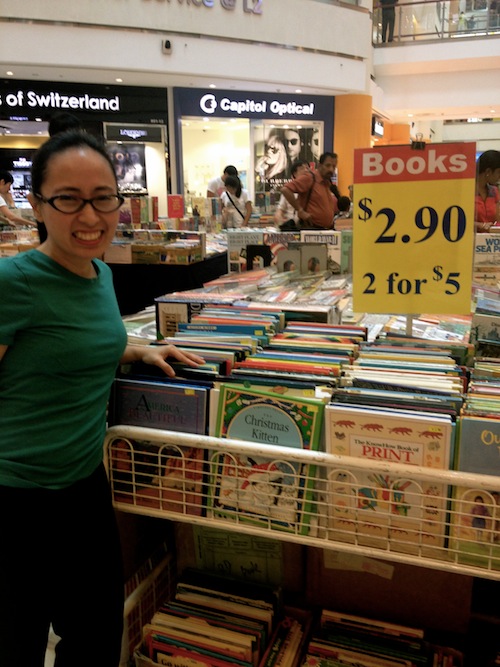
Recommendation #7: Parents and Teachers Must READ.
As Jim Trelease (2006) says, “You can’t catch a cold or a love of books from someone who has neither” (101).
Reading teachers read. (p. 158, Penny Kittle, Book Love)
Students/children need to catch their teachers/parents reading. You can’t preach what you don’t practice. I feel very strongly that teachers and parents themselves must be readers so that they would be able to discern which book might be perfect for a child at a specific juncture or point in their lives. They need to be constantly updated by new titles that are out there and are available in our amazing public libraries here in Singapore. My fear is that the AR program may be used as a convenient cop-out for teachers or even parents who would rather refer children to the AR list to get their students/kids to read (and to select books on the basis of points rather than interest), instead of exploring new titles themselves.
Recommendation #8: Organize Book Clubs
If we truly want to develop readers, they need to be able to interact with likeminded individuals who share their passion with the written word. It would be lovely to hear them argue about a plot, reflect on a character’s folly, laugh about the same series that they are reading, and challenge themselves by reading more complex materials as they gain greater confidence and perceive themselves as readers.
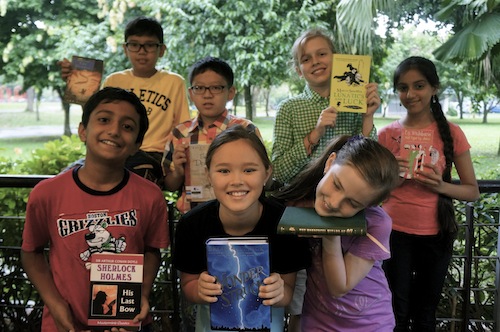
Let me end this longwinded post by an extract from Penny Kittle’s Book Love:
It’s hard to write about love. There are a lot of cynics out there. They’ll tell you love is lots of things love isn’t. Not just book love, which really makes the cynics snicker, but any love. You cannot manufacture love. Love is something that does not respond to “must,” or force, but love is deeply rich, hopeful, and lasting. We leap – we follow – we rest in its peace. When we know love, it owns us. I believe once we love books, it lasts. And once we know love, we pass it on… (p. 93)
I will be seeking that first-love experience for some of the students I’ll meet this fall; they don’t know yet what books can do. I’ll be trying to charm others back to books that once captivated them. And I’ll work to keep others burning with passion and interest- across genre, over time, from what is easy to what will compel them to struggle and grow.
But with every one of them, it is love that I’m after.
Book love is what we need. (p. 95)

I TOTALLY agree with you about a lot of this. For me, I read a ton more books than are on the AR list. I don’t look at the AR list before getting books. I just get it, read it, then check to see if it is on the list. FYI – there is a form you can fill out at the AR site to request that a book (or books) be added. I ask my mom to do that a lot. For newer books there is a list of “coming soon” books that you can get on an email list and get notified when the tests are out. For me I look at AR as kind of like my sport and I like the competition of trying to break the record. I also think the points thing is odd. I’m not sure how they figure out the point value of some books and why don’t the point values go higher than 49?!? I read Harry Potter and the Order of the Phoenix in like 4 or 5 days. It is worth 44 points. I am getting through The Complete Works of Sherlock Holmes (all 4 novels and 56 short stories). So far I’ve been reading it for 2 months (the language is awesomely challenging for me) and 1. it isn’t on the AR list AND 2. even if it was I can only get 49 points for it!!!
On the other hand I know a lot of kids at my school who wouldn’t read if it weren’t for AR and some of them find a cool series that they really want to read.
I totally agree with you about graphic novels. They are not on the list like they should be. Classes in our school compete for prizes (some reason 90% of the time my classroom wins… weird 😉 ). Plus my school gives out prizes for getting points which is kind of cool.
I really like your idea of a reading journal. 🙂 I still don’t list all the comics I read on it. Maybe I should!
LikeLiked by 1 person
Hi there Erik! I’m also curious – is the AR being used as part of your grades in school? Apparently in my daughter’s school, different teachers use it in different ways.
And Sherlock Holmes, wow! Haven’t even read that yet. 🙂
Harry Potter at 40++ points, another wow. Now I understand why even some of the reluctant readers in my daughter’s school are suddenly reading Harry Potter! 🙂
I’m really glad to read your thoughts about this, Erik. I was actually thinking of you as I drafted this post as I know that you’ve already exceeded your reading goal.
LikeLike
AR isn’t usually for a grade, it just promotes reading books other than what we are required to read, and if you get 50 points, you get to go to an “AR Carnival” at the end of the school year and you get a T-Shirt. 100 gets you a sticker/banner, and 200 gets you onto a plaque. 🙂
LikeLike
Hi, Myra. I share your concerns about accelerated reader. I think leveling books can be helpful for kids who are just learning to read, but I too cringe when I hear people telling kids to read at their reading level. In graduate school, I have been studying what parents and librarians can do to help kids become motivated, engaged readers, and offering rewards and points for reading is not suggested by any studies. Instead, giving students choice about what to read, surrounding them with books, offering kids books that are relevant to their lives…etc. You suggest several great ideas. I agree 100% and would have even more reservations given the fact that the AR books are US books and less likely to be relevant to kids.
LikeLiked by 1 person
Hi Amy. I find the entire point system very disturbing and highly dubious. What is the basis for the points, who makes these points? And reading only the books that suit one’s reading level? I find that to be a contradiction to the supposed objective which is to encourage kids to read more.
LikeLike
I enjoyed Diary of a Wimpy Kid, but I don’t understand why my complex historical verse novel, The Surrender Tree, is worth fewer points. I find the point system disturbing, and frankly, quite arrogant. The true joy of reading comes from having a wide variety of choices available, with each reader free to choose according to interests. This is true for both children and adults. When I was ten, I chose to read grownup books, because I wanted to learn about different countries, and multicultural children’s books were not yet available in the U.S. When I was fifty, I started reading children’s books again. At both ages, I thrived on free choice, not choices imposed by others.
LikeLiked by 1 person
Hi Margarita, I really appreciate reading your thoughts here. Like you, I am immensely disturbed by this, which is why I couldn’t help but blog about this. I feel constricted by the AR list which for me, seems extremely limited, yet at the same time touting itself as THE list of books that children MUST read for them to earn the requisite points for students to reach their reading goals. How confining is that! I haven’t even typed other poetry books that I love, but once again the genre seems marginalised and not provided as much value as it should be receiving.
LikeLike
Hi, Myra! First, let me say that your essay is wonderful. I hope you can submit it to a journal somewhere.
Second, I haven’t come across the AR program myself, but many of its tenets sound familiar, especially the idea of assigning points for one’s reading.
Third, your Concern #1 reminded me strongly of one of the earlier chapters in To Kill a Mockinbird. In it, Scout starts school and her teacher, upon discovering that she can read more advanced texts than her classmates, looks at her disapprovingly because she is reading beyond her level. Her teacher tells her to tell Atticus to stop reading to her. That is the kind of teacher I would like to whack on the head.
Like you, I see the purpose of labeling books according to reading age. It provides a good shorthand for parents and teachers who aren’t as exposed or knowledgeable about books. Which is why I think you hit the nail on the head with your recommendation #7.
I think programs like AR exist and are driven by the fact that very few english and reading teachers are as well read as we expect them to be, not to mention parents. The AR program sounds like a packaged thing, something that can be sold to schools across the world, and yes, I agree that, for all its advantages, in the long run, it doesn’t encourage kids to love reading for the sake of reading, doesn’t encourage teachers to explore books on their own, doesn’t encourage any engagement between teacher, student, and page. And I am with you in asking what the purpose is of a reading program that doesn’t encourage a lifetime love for reading?
But, it being packaged and something that can be easily distributed, I can see why it’s attractive to many teachers and administrators, not to mention the idea of gamifying reading with the points. Would I use it if I were still teaching? No. Although I don’t have the kind of exposure to children’s books that you have, I am of the opinion that your other suggestions are more effective in developing lifelong readers and more effective for me in terms of assessing the reading level of my students.
Would I recommend it to other teachers? I frankly do not know. I think it would depend on the teachers and the school situation. Because the only way I can think of making programs like this (i.e., assigning faulty points to books, not having a wide selection of titles, assessing students’ engagement with the text via multiple choice tests) unnecessary is through massive teacher training. The teacher has to be a reader, has to know what books are out there, has to have a sophisticated way of looking at reading, has to have a wealth of strategies in order to get the students to talk about what they think of the book, has to be non-judgmental when it comes to choice of reading material because, really, who wants to be judged when one reads to enjoy?
To that end, I wanted to ask if you’ve heard about this book: “The Smartest Kids in the World”? http://www.amandaripley.com/books/the-smartest-kids-in-the-world I was reading about it earlier today, and I’d like to get my hands on it, because as a former teacher trainer, my thing really is how to reform education by equipping the teachers properly.
Anyway, this has become an overly long comment, but I do enjoy teacher talk, especially when it comes to encouraging reading. One final thing: thank you for mentioning Readicide. I’ll be adding that to my to-read pile.
LikeLiked by 1 person
Honey, thanks for copying and pasting your FB comment here. Will also copy and paste mine with a few more added thoughts:
That is my greatest frustration: Teachers who Don’t Read, those who are clearly out of touch with the new titles that are out there. Those who regard contemporary YA fiction, graphic novels, and illustrated novels with suspicion (as if they’ve done something wrong, or are illustrated for the sole purpose of offending their sensibilities and their parameters of what makes for a good book).
I agree that we only have so much time to read. I, for one, know that to be a sad reality. If only I could have 48 hours in a day, I’d be able to read a lot more books. That’s the thing, we make a decision on what to do with our time. If we can make time for social networking websites, why can’t we do the same for reading? It’s a choice that we make. It’s not the “lack” of time but the fact that we choose what to do with our time, and for some teachers, reading is not part of that choice.
Before reading Readicide, I encourage you to read Book Love by Penny Kittle. I was in tears after I’ve read the book. I’m now starting with “Notice & Note: Strategies for Close Reading” by Kylene Beers & Robert E. Probst – it also promises to be such a riveing read. And NOOO, I haven’t heard of The Smartest Kids in the World yet, will check out your link and check out our public libraries if we have it, and will definitely borrow it. I just checked: there are 23 copies of The Smartest Kids in the World in our public libraries. ALL books ARE either OUT OR RESERVED. I am in Singapore indeed. 🙂
LikeLike
Thanks for posting your comment here, too!
Anyway, reading and English teachers who don’t read is my frustration, too. But having done teacher training across the Philippines, I can’t completely lay it all on the teachers.
It’s true what you say: that each teacher decides what to do with his/her time. However, systemic change would go a looooooong way towards encouraging the teachers themselves to read more. And the change or adjustments can come from the government or, at less macro level, the school admin themselves.
I’m thinking specifically of public school teachers and even teachers in private schools that don’t belong to the top 10% of private schools in the Philippines. I don’t want to excuse the teachers entirely, but there is something soul-crushing about teaching a total of 6 hours a day, everyday, with classes numbering to 50-70 kids, if they’re lucky. And then add administrative or committee work to that, plus the pressure that they must abide by a curriculum that might not be so easy to understand (that is putting it nicely). To top it all off, there is also the lack of accessibility to good reading material to contend with.
I mean, sure, there’s Book Sale and there are book drives left and right, but to teachers who get paid minimum wage (I’m referring here mostly to private school teachers, most of whom still get paid lower than public school teachers.), spending on your own for books is a difficult decision. Book drives, too, mean that they’ll have to comb through the books given to find gems. And again, I don’t think a great many make time for that.
I would love to equip all reading teachers with the desire to read more, to make more time for reading, to think of more creative ways to engage their students with books. But I think for that to be possible in a scale that matters, I have to look for a systemic and coordinated change in the school system.
By the way, I’ve started looking for Book Love, and my go-to site, Amazon, doesn’t have a Kindle edition. Which means I have to look for the print book. If I can’t find it here in the local bookstores, I’ll likely order it from The Book Depository. Unfortunately, public libraries here aren’t so easy to come by. Alas.
LikeLike
Hi Honey, your comment reminded me of that time when I conducted a teacher-training workshop in one of the remote provinces in the Visayas region several years back. I came armed with my powerpoint slides, just about ready to discuss how they can address the “socio-emotional” concerns of their high ability learners in the classroom. Mid-way I begin to realize that these theories are meaningless to them. They had to cope with something more vital and more pressing – the issue of survival that even talking about something as important as SEL seems like a superfluous task. I understand these realities as I witness it firsthand. And while we help organize book drives, arrange for massive book donations and such – and it does alleviate the students’ and the teachers’ needs for awhile and make us feel good about what we do with our time – at the end of the day, it’s very evident that these are nothing but band-aid solutions. I told my daughter once when we had our 1:4:1000 book drive (donated 1000 books to four schools for our blogiversary) that we’ve done what we could at that point, but it’s hardly enough. It would never be enough.
You are right in noting that it has to be more systemic and structured with governmental and societal support. We listen to the news every day (my husband is tuned in to the AM radio station for practically the entire day), and we are devastated (crushed actually is the word) to realize that the Philippines is actually a rich country plundered mercilessly by elected officials who should know better, but don’t. It is enough to make people raise their hands and surrender – as all avenues seem knee-deep in corruption. Yet we move forward, crawl if need be. Because that is how we survive.
This also reminded me of a passage in Penny Kittle’s “Book Love” I hunted for it and will copy it here for you:
“I ran into a moment like this last week when a former colleague got upset about an interview I’d videotaped with a student who said he did not read in middle school the year before. ‘I know what you’re doing here, and I’m telling you you’re asking the wrong questions,’ he nearly shouted at me. ‘Reading doesn’t matter. What you should have asked him – have you eaten today? Will you be sleeping at home tonight? Reading means nothing to him’
And I almost agree – but I don’t.
I know about the kids who have little because I was one during a few dark years in my childhood. Food mattered. Hand-me-downs mattered. My dad’s drinking mattered. But I also know that reading saved me. Reading saved me because I escaped into the world of “The Great Brain” and imagined a different life. And maybe all I’m doing is saving myself again and again when I track down one book for Adam tonight, ordering it and paying for it myself, on the chance that he will read. On the chance that it might be pleasurable and meaningful and it might show him light in an otherwise dark life, which includes his father’s incarceration. And maybe that doesn’t matter. Maybe my colleague is right and all my efforts for this kid this year will fail. That will hurt. But doing nothing would hurt more. i’m not giving up on the healing power of story. And I’m not giving up on facing the truth about practices that distance kids from books instead of pulling them near. Because reading matters. It is foolish to think otherwise.”
– p. 154, Penny Kittle, Book Love
I hope you find the book, Honey. And I’m sure when our collective minds are gathered together, we’d make our voices heard. Maybe later rather than sooner, but it will come.
LikeLike
This is a thoughtful and beautifully crafted essay, Myra. I am in strong agreement with what you say. We did use the AR program in the international school in which I worked, with a certain amount of success, I believe. We had a very good library budget, so for the few years I was running the library, I made it one of my projects to stock up on as many varied AR titles and quizzes as possible. Also our primary school was bilingual and our secondary school and 2/3 non-native speakers; reading in English was weak for many of the students, and I do believe that a good number of students and teachers benefitted from the structure. We added an additional award system as we felt the points given (and levels often) were weird. I had more than one junior high kid tell me that due to the AR program they were reading books in their entirety for the first time ever! Also AR books were never the only books offered to or read by children. I felt it was at its weakest as a program for the stronger readers, whom, if I had had my choice, I would have released completely from the rigidity of the structure and limitation of choice.
I love the other suggestions you offer to help develop children’s reading. I wish I could say that all teachers would have the time and inclination to adopt these. Many will and many won’t.
As for the question you pose, I do not have enough data to answer accurately whether the AR program develops lifelong readers. My inclination is to say that very few of the children who came through our library would be lifelong readers judging by their interest in books through junior high and high school. My hope is that many will come to reading for pleasure as adults.
LikeLiked by 1 person
Hi Joanna, thanks for sharing your experience with AR. I am actually surprised that you had it in France? I find the reach of the program quite extensive in that case. I suppose it makes sense as well given that its entry is through international schools.
I know what you mean about the lack of time. That is always the battlecry of most of the teachers I talk to. It is what it is, I suppose. I always think that it’s not a question of not having enough time, it’s really a question of finding the time – and if there is no such space to be found, it’s Making the time. 🙂
LikeLike
I will try to look for more about the program, but mostly what I know is that it’s restrictive, as you showed by the extensive explanation above, Myra. My grandson, in a public school in another state, is in the AR program. Another problem is that when he chooses a book, he is not allowed to reject it and find another one, but must slog on and finish. He doesn’t like reading much anyway & this doesn’t help at all. I visited a favorite Indie bookstore yesterday and a friend who works there told me that often teachers who are preparing to “teach” a book are frustrated because the store (or publishers) don’t have a “novel-ties” or lesson plan for that book. The teachers say something like “you mean I have to read the book!”. I know teachers are so pressed for time, but really they should be reading as much as they can! It’s so important to get the right book into the hands of just the right student! Our biggest challenge at my school, for gifted students, is to find appropriate books for those early accomplished readers, the 7 year olds, for example, who are reading far beyond their age level. We are all for choice, and expanding each student’s world with all kinds of books. Lucky for us that we have a wonderful library and each classroom as well holds extensive collections. I am re-reading Book Love with those teachers of the middle school aged students now-and they love it too! Thanks for this.
LikeLiked by 1 person
Hi Linda, I’m very thankful to the kidlitosphere community (book bloggers) who have been sharing the beauty of both “Book Love” and “Notice & Note” – I’ve heard about Readicide during the NAGC conference sometime in 2011, and I’ve been meaning to get my hands on it. I’m glad I did.
I’ve always felt that if a teacher is a reader it changes the whole dynamics of the classroom altogether, the interaction between child and student, the discernment of the teacher when it comes to a child’s learning needs, there is a different kind of sensitivity that seems to permeate the whole classroom. It just makes a world of difference.
LikeLike
Myra, this is an amazing post! I have used AR in the past, but have learned over the years that you don’t need a points system to motivate students to read. You need good books and a desire to model a love of reading to your students. Introduced to the right book, students will read. See Donalyn Miller’s excellent work in this area.
LikeLiked by 1 person
Hi Jeff, I’m glad you like it. I haven’t read any of Donalyn Miller’s research yet, will definitely look into that. Thanks for sharing!
LikeLike
This really makes me think of Alfie Kohn, and his work on the negative consequences of rewards. In a nutshell, it’s not just AR: external rewards can motivate people temporarily, but the rewards will eventually lose their power. Meanwhile, applying external rewards to people who are already intrinsically motivated tends to kill the internal motivation. This is something I struggle with in education in general, as the prevailing idea even at my son’s otherwise liberal school is that rewards are the best motivation in general.
As a librarian, I also have problems with AR in particular for all of the reasons you’ve mentioned. So often parents come in wanting the right book for their child’s grade level (AR or not), and I have to try to explain to them that far more important than a listed grade level is their particular child’s reading level and most especially interests. If a book is on their level, but not engaging, it won’t work. I always urge kids who have to pick a book for an assignment to take more than one home (they’re free!), so that if the first one they try doesn’t work for them, they have another option.
LikeLiked by 1 person
I am so happy to hear you say this. I’ve always felt that the selection of a book should go way beyond just a recommended reading level based on some test. And I’ve always felt that the most effective librarians are those who truly take the time to get to know the child who comes into the library. If one knows how to “read” people, if one actively listens, and ‘tune in’ to a child’s language, oddities, peculiarities, and uniqueness – one may be able to pick out the perfect book a child needs at a particular time. The work of a librarian is so powerful since handing the right book at the right time to a child can be life-changing.
LikeLike
I LOVE that you have given alternate options to the AR program. I use AR am working to de-emphasize the program in my school. It is only a tool and should not be the reading program.
LikeLiked by 1 person
Hi Shawn, thanks for sharing your thoughts about de-emphasizing the program in your school. You’re right in noting that it only functions as a tool, and parents and children need to be aware that it is only one among the many choices they can play around with when it comes to reading.
LikeLike
I agree completely with you Myra! Honestly, I don’t give a hoot what my kids read just as long as they read. Last year, they launched a project in Emma’s grade 6 class to have the kids read 1 book from each of 7 or so different genres. Once they had read from the listed genres they could read whatever they wanted. I thought that was great project as it forced them to branch out a bit but then go back to what they enjoyed. Heck, I sat in my local library this morning and read picture books by Allen Say, Linda Sue Park, Eric Walters, Michael Rosen, J. Woodson and others. It was 1 hour of utter bliss and oh my goodness, after reading Michael R’s Sad Book and Woodson’s Every Kindness, I was crying. I could care less what people thought of me reading picture books and if the books had been ranked with points, lord knows I probably wouldn’t have accumulate many Should I essentially be punished for reading picture books and not higher ranking books? I think NOT and neither should the kids at your daughter’s school!
LikeLiked by 1 person
Hi Corinne dearest, thanks for copying this here! You are lovely! 🙂 I’ve featured Sad Book during our “Loss, Heartbreak, and Coming of Age” theme – the illustrations painted a vivid portrayal of depression, what a perfect match to Rosen’s grief. And I’ve read Woodson’s Every Kindness to two of my classes this semester – both the teacher trainees and allied educators I taught were simply awed by it.
LikeLike
I am an outspoken opponent of AR. I refer frequently to the research by Dr. Stephen Krashen to support my position. Donnalyn Miller and Nancie Atwel share how to create a classroom environment based on a passion and love for books and reading, not rewards. We are fighting the good fight!
LikeLiked by 1 person
Hi Jessica, I know about Nancie Atwell’s book but we don’t have her latest book on reading in our libraries here. Hopefully, I can still get our office to order it via Amazon, I know that it’s a seminal book since both Gallagher and Penny Kittle cited her book in their writings. Will also check out Donnalyn Miller.
LikeLike
Hi Myra, you make such a powerful argument against this type of “reading teaching.” I think the basis for what we do for our kids as reading teachers is to read voraciously ourselves, and share that passion with our kids. If we make the love of reading the very center of our teaching strategies, our kids will see the value in this and they will read. We live in an age when rich and varied literature is published with great frequency, and our children have abundant choices – as I say to my students, there are just too many great books around to ever feel bored or unenthusiastic about what one is reading. I think though, that we as teaches must accept that there is no easy program (complete with worksheets and project ideas) to lead our kids into reading. We must build that book love and nurture it by sharing great books, teaching our kids how to talk and enrich their experiences of them, and always reaching for a new read with enthusiasm and wonder. It starts with us. Nancie Atwell, Lucy Calkins, and (one of my favorites, Shelley Harwayne) have written much more eloquently than I can about teaching reading – but they all would agree, it begins with a teacher who is passionate about reading, too.
LikeLiked by 1 person
Hi Tara, I am suddenly reminded of Milo in The Phantom Tollbooth: “There’s just so much to do right here.” So so true.
Thank you for mentioning these authors, I shall make sure to hunt for their books down in our libraries here. Sadly, passion is not something we can teach. 😦 But I’ve always felt that the kindling is there, it exists for everyone, it’s just a matter of finding the right book that would set it afire. 🙂
LikeLike
As an elementary reading specialist, I wanted to share this comment that I overheard as I was working at a computer in our library. Fifth graders came in and were book browsing , one commented ,”Wow, this one looks interesting.” The other child agreed, then they checked and there was no AR ‘value’ so they reshelved the book. It just happened to be one of those “perfect’ books for either of those students. I said something to them about , “I am surprised, ladies that you didn’t trust your reading hunch that this book would be good for you. After all, you opened it and read a bit and seemed to like it.” Their response was, “but we are really only supposed to read to get some points” broke my heart. AR certainly will not turn any ‘lukewarm’ reader into an avid one! Sigh!
My goal is always to book talk that ‘this book is one of my favorites, and as I finished reading it , I thought this is just perfect for ______” Yes we teachers have to be book “dealers” and stay current and enthusiastic. I also recommend you investigate The Book Whisperer – Donalyn Miller. I will be hearing her speak later this month- so excited about that!
LikeLiked by 1 person
Hello there Jan, thank you for sharing this. Your comment is exactly the reason why I was compelled to write this post. My fear here in Singapore is that it isn’t just the kids who may think this way. The kids may trust their instincts and get the book for themselves, but the parents who may not have an extensive knowledge of book titles may begin restricting their children’s reading on the basis of those points and to ‘get ahead.’ There are just way too many barriers to choices in reading, and the lack of diversity in the AR reading materials is very disturbing – and the parents or the kids who are part of the program may not be aware of this.
LikeLike
Pingback: [Monday Reading] Southern Ghosts and love for New Orleans |
What happened to reading for fun? Our community has one of the very best libraries around. It is a rite of passage for a child to get a library card. Of course, the digital age has brought tablets and e-books into the mix. Our district has AR for some students all the way through high school. I suppose it is good to encourage students by setting goals for reading. However, my little subversive family would read whatever they could find around the house (usually books they’d read before in elementary) to make their goal and then read what they were really interested in. At 17, I was reading Glamour magazine. At 17, my daughter picked up “The Dialogues of Plato” during one of her breaks as an employee of our wonderful library. I doubt she can AR test on that one.
LikeLiked by 1 person
Hi Paula, in AR’s desire to motivate reluctant readers to read through a rigid point system, the pleasure is lost and the fun too as they need to take ‘tests’ (and multiple choice ones at that) after they’ve read a book. My daughter does the same thing as your kids, she has reached her reading goal several weeks back and is just reading now for the fun of it. Good if it’s on the AR list, but fine as well if it isn’t. I am just worried for those who may regard AR as the only list they should be mindful of in book selection for their kids/students.
LikeLike
Wow, I loved reading this! You make some wonderful points, and I must read Readicide. I am in charge of our school’s AR program, because it is a job requirement and therefore I have to do it, but I can’t say that I agree with it. My heart sinks when a student returns a book to me (I am the library parapro) and says ” I read this whole book for nothing – there isn’t a test on it.” I usually talk to them about the book then, and ask them if they liked it, and say if so, then it wasn’t for nothing. Most of our teachers tell their students to check out a book for pleasure, and one for AR, which is a little better than just focusing on AR. Another thing we do at our school, is we do not set a cap on the grade level students can test on. I can set the levels myself, and they currently can all read and test on the highest level. I will change the lowest levels though, to a grade level below them only, unless the student receives special services and needs the lower level changed.
I agree with you though, I think kids will slam through a bunch of books quickly and without enjoyment, just to increase their points. Or skip over great books because they don’t have a test. This is also a link to how AR assigns the point value – http://doc.renlearn.com/KMNet/R003985016GG79F2.pdf. However, I do agree with you, books can’t be quantified like this, it just doesn’t work.
LikeLiked by 1 person
Hi Erin, I’m grateful for the link you shared. I shall look for that to see how AR does allocate their point values. It’s good to hear variations in the way that AR is conducted. While it does address the issue of the high ability reader, it still doesn’t address the fact that both picture books, graphic novels, novels-in-verse, poetry books seem marginalized at so few points and such a low grade level, notwithstanding the themes covered in the books. There are simply things that can’t be programmed into a computer. You are perfectly right in noting that it should only be used as a tool – the entire quantification process goes wanky if one does not include the qualitative processes such as the interaction between the reader and the book and the big themes that the author is trying to address in the narrative.
LikeLike
I despise AR for all the reasons you’ve stated. It’s fine in lower grades but once kids are confident readers it means nothing. Plus goals for strong readers become punishing. 60 points in a marking period is 300 pages/week. My son just stopped reading and lied about taking tests. Also, our PTA privately funds the program. What a waste of $.
LikeLiked by 1 person
Hi Jill, Gallagher I believe has also pointed that out. The money that schools often shell out for these programs can be more profitably used instead for massive teacher training and professional development that would make teachers more cognizant of the new novels that are out there that may resonate with their own students. I could see its attraction though, as it makes things easier, more convenient, but ultimately less rewarding for both teacher and student.
LikeLike
Former school teacher, now librarian, always a mom, here. I think many US schools are moving AWAY from AR, thankfully, so I was surprised to see a school enthusiastically buying into it. One of my (many) complaints when I was teaching middle school, besides what you mentioned here, had to do with the reading levels. Kids are given a range that they have to read books in (and, I don’t care what they say about it being supplemental, it quickly takes over – after all, it’s easy to grade when the computer spits it out for you!) An eighth grader reading 8th grade books is good, right? So, find me one. What many adults don’t realize is that ADULT fiction is written on a 5th/6th grade reading level. So is your favorite magazine or local newspaper. Our illustrious governor recently came up with her own summer reading program, and insisted on kids reading at their grade level. In her next breath, she mentioned her favorite book, and I looked it up – 5th grade reading level. Draw your own conclusions.
Another complaint can use dinosaurs as an example. “Pterodactyl” is hardly a 2nd grade word, but find me a 2nd grader who doesn’t know what that is! If a child is interested in a subject, he probably knows related words that are above his ‘reading level’, yet he wouldn’t be allowed to read books that contain them (because, of course, we have to get our required points in for the month, no time for fun reading any more!)
And then there’s the whole set-up: read a book, take a test. Read a book, take a test. Gosh, why wouldn’t that make you want to read more books? Ugh!
LikeLiked by 1 person
Hi Ami. This is very good to know (about schools in the US gradually moving away from AR). That is valuable information. The reading levels just drive me nuts as everything seems so arbitrary and based on extremely shallow and superficial points that totally miss out on a lot of the subtlety of the book’s content and the multiple ways in which the book can be used across different levels – which would take an extremely skilled and committed teacher to realise and make full use of in the classroom. I had to laugh out loud as I read a few of the points you shared here about most ‘adult’ novels being 5th/6th grade level books in essence. As one of my very good friends have pointed out when I shared this post on FB, it is very disturbing how much our society is so numbers and test-driven.
LikeLike
Pingback: This Week’s “Round-Up” Of Useful Posts & Articles On Education Policy | Larry Ferlazzo’s Websites of the Day…
Pingback: [Nonfiction Monday Reading] A Week-long Tribute to the Master of Macabre, Edgar Allan Poe |
I use the A.R. program at our elementary school in Swartz Creek Michigan. I love the program for the variety of levels, genre’s, and large selection of books to choose from here .As is the case with anything, this program is not a panacea for reading instruction or the sole tool used to build readers who love reading. I believe the biggest draw back that cannot be changed in this discussion is that many, many teachers aren’t readers themselves and try to smoke and mirror things by using a program like this. An erudite individual is built, not born with all knowledge being innate in the human species. It comes through discourse and research and yes reading. I think teachers need to look at themselves and see if they are the model of a reader who passes on that love of the written word. Literacy comes in all manner, but sadly most teachers are not really lovers of literacy in it’s myriad forms. As Shakespear would say..therein lies the rub. I have amazing talks with former and present students as well as people I meet wherever I go about books and the world of ideas that are planted within us. Teachers, do you read to your students? Do you read when they are reading? Do you share all the incredible things that transpire in our world, or have transpired in it’s history. I see way too many new ways to approach teaching, Too many grabbed as the magic that will change the world, as things that work fall away in pursuit of the next new shiny bauble of Education!
LikeLiked by 1 person
Hi Cary, Thank you for sharing your experience with AR. I agree that this program should not be used as a panacea for a literature program in school. It becomes terribly problematic if AR is used as a quick-fix without really thinking the programme through. It has its uses as you pointed out, but it would never replace ‘reading’ teachers who truly have a passion for books.
LikeLike
Pingback: [Monday Reading] A Collection of Creepy and Questionable Creatures |
Pingback: [Monday Reading] Modern Retellings of Classics in Children’s Literature: The Butterfly Ball, Arabian Nights, and Alice in Wonderland |
Hi Myra,
I love this post! I am a children’s librarian in Fairfax, Virginia. Virginia has begun putting students’ tested “Lexile level” — yet another commercial product — on the state Standards of Learning tests. Just this week, a parent for whom English is a second language came in looking for books that matched the number on the test results.
First, we had to figure out that’s what it was. Then my co-worker bent over backwards to find books that would match that Lexile level. I tried to tell her that should *not* be the first consideration when selecting books for kids, but she said that’s what the parent wanted.
Now, in this case the child was reading “below grade level,” so I can see how that information might help pick books that are a little less frustrating and help her gradually increase her reading level. But if anyone uses that sort of information to confine a child’s reading, I think it’s a terrible thing.
And I agree with you completely. Once an adult is a proficient reader, we choose our reading by what interests us. Once kids have mastered decoding, let them read what interests them, for heaven’s sake! And, while they’re learning decoding, if you let them read what interests them, they will progress much more quickly. If what interests them is at a “lower” reading level, well, that certainly won’t hurt their decoding ability.
LikeLiked by 1 person
Hi Sondy, thanks for sharing your experience and your thoughts about this. I could see that this is getting to be the trend quite recently – the Lexile leveling process seems to have permeated most schools across different countries. I’ve always thought that children had a self-regulating mechanism of sorts – if the book is too much for them (either they don’t comprehend it or the themes are too heavy for them, too scary or too complex), they would tune it out. At the same time, books should also be able to find the child at the right moment. As an adult, I do believe that books find me at the exact moment I need them – I believe the same thing for even very young children. There is just something about the book and them that simply clicks – and the child becomes a reader. This is something that will not be captured by the lexile or AR levels. That being said, I am with you in noting that it has its usefulness – but I think we should always be cautious in noting that they are instruments/tools rather than the primary/exclusive reason why children should/must read what they read.
LikeLike
Pingback: [Monday Reading] The Enchanting World of Faeries |
Pingback: [Monday Reading] Dream Keepers and Peddlers of Dreams |
Pingback: [Monday Reading] A William Joyce Guardians of Childhood Special |
Pingback: [Monday Reading] Touched by the gods and being one’s own Creator |
Pingback: [Monday Reading] Her Stories, Mother Sky and Little Night |
Pingback: [Monday Reading] Welcome to Faeryland |
Pingback: [Monday Reading] The Christmas Story from the eyes of Wild Animals |
Pingback: End of Year Book Survey 2013: A Collaborative Blog Post from the GatheringBooks Ladies |
Pingback: Does the Accelerated Reader Program help develo...
I am a University Professor who recently moved the family across the United States and my daughters are now in a school with AR reading. My oldest daughter went from a straight A student in a pre-ivy league school that absolutely LOVED reading to completely refusing to read!! In fact, she used to love reading so much that I would catch her reading all night long! She read books that are considered “above” her AR level that she is now no longer “allowed” to read according the AR reading program! Now we are fighting with her to get her to read even the most simple book – and she will state that “she hates reading now because its boring”!!! In my opinion AR reading has done irreparable damage to my daughter’s sense of wonder and excitement over reading! In fact, I would absolutely avoid ANY school that uses the AR reading system! My daughter tested grades above her class at the beginning of this school year….but after several months of the AR reading program she is now tests well below her class level!! As an educator, I find this entire system to be very counter productive!!! I can not believe that this system was “sold” to so many schools as a good way to test/teach reading!! Someone has definitely been sold a “bill of goods”!!! As a Professor, I will tell you that this program will absolutely kill your child’s sense of excitement for reading and as a parent, I will passionately fight this system with every fiber in my being!!
LikeLiked by 1 person